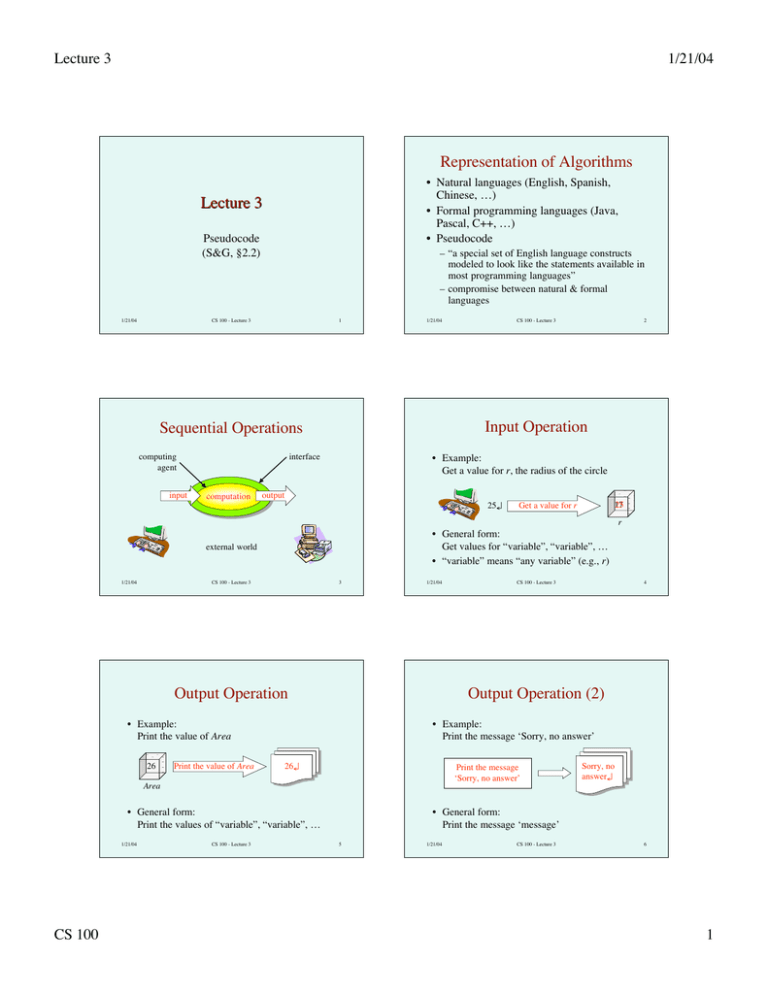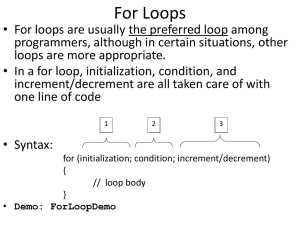Lecture 3 Representation of Algorithms 1/21/04
advertisement

Lecture 3 1/21/04 Representation of Algorithms • Natural languages (English, Spanish, Chinese, …) • Formal programming languages (Java, Pascal, C++, …) • Pseudocode Lecture 3 Pseudocode (S&G, §2.2) 1/21/04 – “a special set of English language constructs modeled to look like the statements available in most programming languages” – compromise between natural & formal languages CS 100 - Lecture 3 1 1/21/04 input interface computation 2 Input Operation Sequential Operations computing agent CS 100 - Lecture 3 • Example: Get a value for r, the radius of the circle output 25↵ 17 25 Get a value for r r • General form: Get values for “variable”, “variable”, … • “variable” means “any variable” (e.g., r) external world 1/21/04 CS 100 - Lecture 3 3 1/21/04 Output Operation Print the value of Area • Example: Print the message ‘Sorry, no answer’ 26↵ Print the message ‘Sorry, no answer’ Area • General form: Print the values of “variable”, “variable”, … 1/21/04 CS 100 CS 100 - Lecture 3 4 Output Operation (2) • Example: Print the value of Area 26 CS 100 - Lecture 3 Sorry, no answer↵ • General form: Print the message ‘message’ 5 1/21/04 CS 100 - Lecture 3 6 1 Lecture 3 1/21/04 Computation is Physically Instantiated Computational Operation • Example: Set the value of Area to π r2 2 cm π = 3.14… ππ ×× (2 (2 cm/2) cm/2)22 25 = 1963 1963 177 Hg Area r 3 cm compute 3.14… × (252) 2 ×× 33 cm cm ×× 13.55 13.55 g/cm g/cm33 == 127.7 127.7 g g 127.7 g • General form: Set the value of “variable” to “arithmetic expression” 1/21/04 CS 100 - Lecture 3 7 1/21/04 Computational Processes in General • An input process translates an external physical situation into the computer’s internal representational medium • Example physical situations: – in which patterns can be represented – by means of which they can be manipulated • Example computational media: – – – – – electrical signals & charges – light intensity, fluid pressure, molecular structure, quantum state, gear position (old), abacus beads, paper, blackboard, etc. CS 100 - Lecture 3 9 CS 100 if true characters on display screen or printer graphics images position of robot arm etc. CS 100 - Lecture 3 CS 100 - Lecture 3 10 Conditional Operation • An output process translates the computer’s internal medium of representation into an external physical effect • Example physical effects: 1/21/04 position of mouse or joystick position of key (depressed or not) signal from light sensor etc. 1/21/04 Output Processes in General – – – – 8 Input Processes in General • Computation takes place in a medium 1/21/04 CS 100 - Lecture 3 true/false condition do one set of operations if false do another set of operations continue 11 1/21/04 CS 100 - Lecture 3 12 2 Lecture 3 1/21/04 Conditional Statement General: If “true/false condition” is true then One-Branch Conditional Example: If (ci ≥ 10) then if true Set the value of ci to (ci – 10) Set the value of carry to 1 “first set of algorithmic operations” do one set of operations Else Else (or Otherwise) Set the value of carry to 0 “second set of algorithmic operations” if false If “true/false condition” is true then “first set of algorithmic operations” do nothing (rest of algorithm) continue (rest of algorithm) 1/21/04 true/false condition CS 100 - Lecture 3 13 Computer-Inspired Conditionals in Legal Drafting 1/21/04 CS 100 - Lecture 3 14 Basic Loop (Trailing Decision) Subsection (a). IF AND ONLY IF (1) (A) A person has threatened or attempted suicide or to inflict serious bodily harm on himself, OR (B) The person has threatened or attempted homicide or other violent behavior, OR (C) The person has placed others in reasonable fear of violent behavior and serious physical harm to them, OR (D) The person is unable to avoid severe impairment or injury from specific risks, AND do loop body if not, repeat (2) There is a substantial likelihood that such harm will occur, THEN (3) The person poses a “substantial likelihood of serious harm” for purposes of subsection (b). test if done if done, continue — Tenn. Code Ann. sect. 33-6-104(a) (1991) 1/21/04 CS 100 - Lecture 3 15 1/21/04 Iteration (Trailing Decision) 1. Set the value of count to 1 2. Repeat steps 3 to 5 until (count > 100) 3. Set square to (count × count) 4. Print the values of count and square 5. Add 1 to count termination condition loop body (rest of algorithm) 1/21/04 CS 100 CS 100 - Lecture 3 16 Example Loop Repeat steps i to j until “a true/false condition” becomes true step i: operation step i + 1: operation … step j: operation CS 100 - Lecture 3 17 1/21/04 CS 100 - Lecture 3 18 3 Lecture 3 1/21/04 Leading Decision Loop Alternate Notation Repeat until “a true/false condition” becomes true “a set of algorithmic operations” End of loop if not test if more if more and repeat do loop body While “a true/false condition” remains true do “a set of algorithmic operations” End of loop continue with rest of algorithm 1/21/04 CS 100 CS 100 - Lecture 3 19 1/21/04 CS 100 - Lecture 3 20 4




